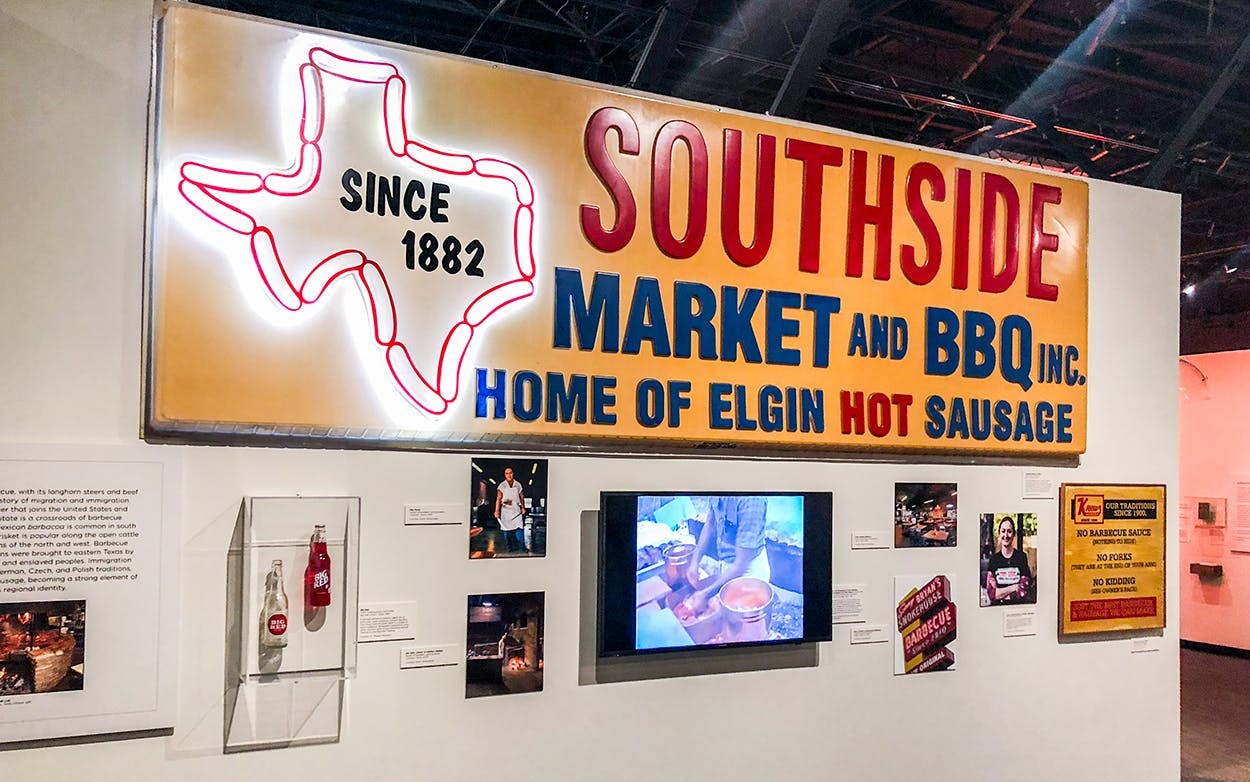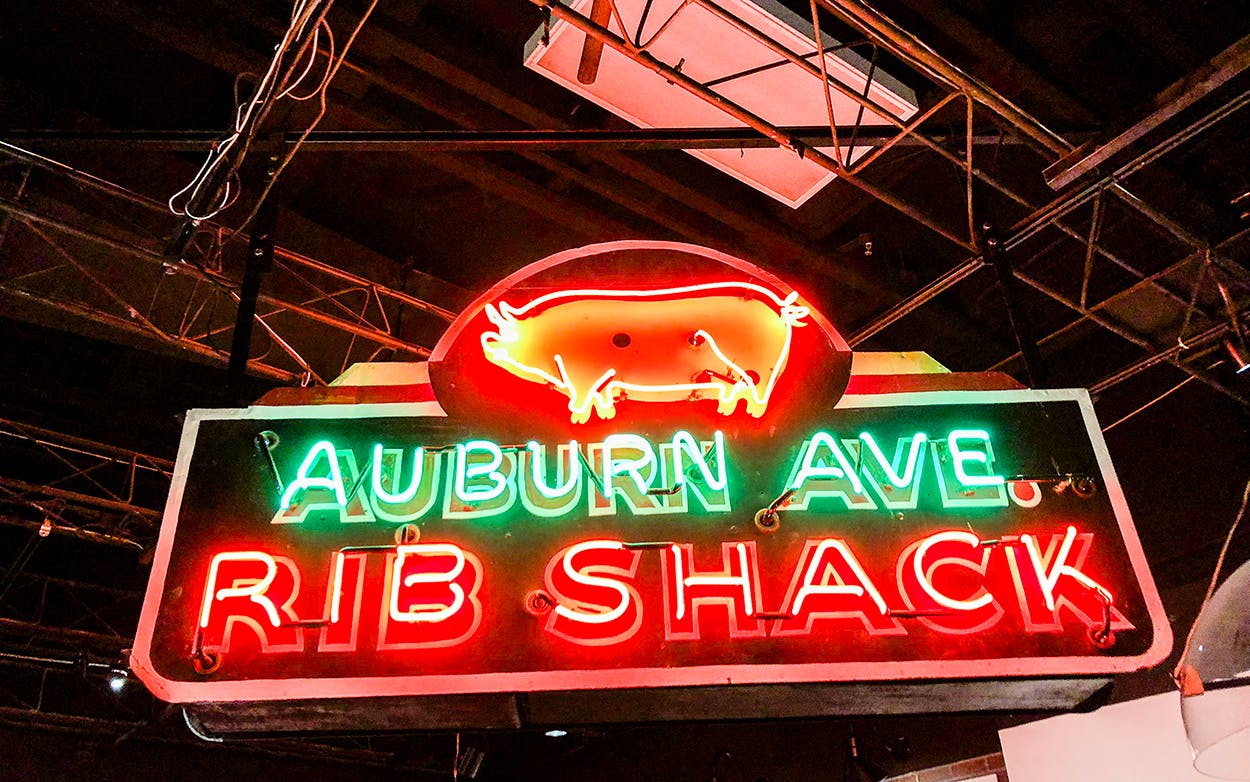When Jim Auchmutey, the consulting curator of the Atlanta History Center’s barbecue exhibit, was asked by the museum which barbecue joint signs he hoped to include, he chose some familiar names. The neon pig above Big Bob Gibson’s Bar-B-Q in Decatur, Alabama and the tuxedoed pig spinning a cane above Leonard’s Pit Barbecue in Memphis were both strong contenders. “But you know what? You’ve got a top ten sign in your basement right here,” Auchmutey told museum staff. The Auburn Avenue Rib Shack had been located a few blocks down from Martin Luther King Jr.’s church in Atlanta (although King reportedly preferred Aleck’s Barbecue Heaven a few miles over on the west side) and was a local favorite until its last day of business in 1999. Don Rooney, the History Center’s Director of Exhibitions, had arranged for storage of the sign after the restaurant closed. Auchmutey knew he had found the centerpiece for the exhibition.
Barbecue Nation, an exhibition that opened in May at the Atlanta History Center, was supposed to debut a decade ago. At the time, Auchmutey was writing for the Atlanta Journal-Constitution, and the museum asked if he’d write a companion book for Barbecue Nation. After the recession hit, potential donors lost interest, and the ideas for both the book and the exhibition were shelved.
The History Center revived the project in 2016, and Auchmutey got back to writing about barbecue. When the original curator, Craig Pascoe, moved last year, he stepped in as the consulting curator. He had collected so much historical data and so many ideas for displaying it that the museum would have needed another wing to use it all. “I was trying to stuff too much stuff into a limited gallery space,” Auchmutey said. He credits lead curator Jonathan Scott for some heavy editing to translate Auchmutey’s vision into the allowable square footage of the exhibit. The joint efforts have provided an educational experience as well as a nostalgic one.

Auchmutey had hoped for separate rooms dedicated to both Texas barbecue and barbecue in the Deep South. They live together in the exhibition, with the bulk of the Deep South’s representation coming from North Carolina’s Skylight Inn. It’s known for whole hog barbecue, and one of the old chopping blocks was sent from its home in Ayden to be displayed. Texans may recognize the large sign on the other side of the room from Southside Market. It once hung above the entrance to the oldest barbecue joint in Texas when Southside was still located in downtown Elgin. When I asked Auchmutey about why other barbecue styles only merited brief mentions in the exhibition, he said, “The two biggest [regional barbecue variations] are deep south barbecue and Texas barbecue.” The rest, he said, “all pale before those two.”
The exhibition covers everything from the Caribbean origins of our barbecue culture to the current state of competition barbecue. Grilling gets plenty of attention too, like the original model Char-Broil grill on display, with handles and a single wheel to be rolled around like a wheelbarrow. Alongside it is an early Weber kettle grill that’ll look familiar, and a GE Partio Cart—an all-in-one grill, oven, and rotisserie—that probably won’t. The cart belonged to President Eisenhower, and is on loan from the Ford Museum in Dearborn, Michigan. The exhibit also has more modern artifacts, like a six-foot-tall burn barrel from Charleston pitmaster Rodney Scott, who just won a James Beard award.
Georgia gets plenty of attention at the Atlanta-based exhibition. While we toured, Auchmutey pointed out an image from a 1954 issue of The Saturday Evening Post. Above an article titled “Dixie’s Most Disputed Dish,” his grandfather, Bob Auchmutey, was pictured manning the barbecue pits at the Euharlee Farmers Club, where locals have held an annual barbecue since the 1880s. Although barbecue runs in his family, Jim went to his first Euharlee barbecue a couple weeks ago, where 800 people gathered to eat pork shoulder and Brunswick stew.


“We do feel that barbecue in the most quintessentially American food,” said Auchmutey, explaining why the museum the exhibition was so necessary. The team of curators also felt a responsibility to tell the story of barbecue differently than previous white-washed versions. “For most of the history of barbecue, of course, a lot of those ethnicities, and certainly the gender issue, was largely written out of it,” says Auchmutey. On one wall in the exhibition, an image is emblematic of the museum’s mission: an African American woman works at a barbecue pit in Harlem, her hands are held wide and head thrown back with a welcoming smile as she poses for the photo with her barbecue. A quotation above the image, attributed to James Beard, reads, “Outdoor cooking is man’s work.” It’s a fitting jab at sexism in barbecue, especially in the same year that Tootsie Tomanetz, pitmaster at Snow’s BBQ in Lexington, was a semifinalist for a James Beard award.
The exhibition will remain up at least until summer 2019. They have a few more barbecue events planned, including Hogtoberfest, a whole hog barbecue demonstration on the attached Tullie Smith Farm on October 5. Meanwhile, Auchmutey is back to work on Smokelore, his companion book, and plans to release it in May 2019. Luckily, the book doesn’t have the same physical constraints as the exhibition space, so he’ll have all the room he needs to tell the whole story of American barbecue within its pages.
- More About:
- Black BBQ








